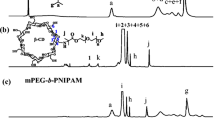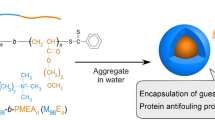Abstract
Block copolymers of poly(N-isopropylacrylamide) (PNIPAM) with both a hydrophobic segment and a hydrophilic terminal group in the same chain were synthesized by reversible addition-fragmentation chain-transfer (RAFT) polymerization. One is a diblock copolymer with only hydrophobic poly (stearyl methacrylate) (PSMA) segment, while the other is a triblock copolymer with both a PSMA segment and a hydrophilic terminal group. Uniform spherical micelles were obtained. The triblock copolymer micelles showed a distinct evolution, first becoming small, then becoming larger, and finally becoming stable. The transition process was fast and reversible with temperature. Although the hydrophobic PSMA chain segment lowered the lower critical solution temperature of the diblock copolymer micelles, that of the triblock copolymer micelles was almost as high as that of the PNIPAM homopolymer. In the triblock copolymer, hydrophobic chains and hydrophilic segments co-existed, and their opposing effects partially canceled. The hydrophilic terminal group on the triblock copolymer made a great difference.












Similar content being viewed by others
References
Li XY, Gao Y, Boott CE, Winnik MA, Manners I (2015) Non-covalent synthesis of supermicelles with complex architectures using spatially confined hydrogen-bonding interactions. Nat Commun 6:8127
Li XY, Gao Y, Boott CE, Hayward DW, Harniman R, Whittell GR, Richardson RM, Winnik MA, Manners I (2016) “Cross” supermicelles via the hierarchical assembly of amphiphilic cylindrical triblock comicelles. J Am Chem Soc 138(12):4087–4095
Palmer LC, Stupp SI (2008) Molecular self-assembly into one-dimensional nanostructures. Acc Chem Res 41(12):1674–1684
Jeong B, Bae YH, Lee DS, Kim SW (1997) Biodegradable block copolymers as injectable drug-delivery systems. Nature 388(6645):860–862
Pang XC, He YJ, Jung JH, Lin ZQ (2016) 1D nanocrystals with precisely controlled dimensions, compositions, and architectures. Science 353(6305):1268–1272
Convertine AJ, Lokitz BS, Vasileva Y, Myrick LJ, Scales CW, Lowe AB, McCormick CL (2006) Direct synthesis of thermally responsive DMA/NIPAM diblock and DMA/NIPAM/DMA triblock copolymers via aqueous, room temperature RAFT polymerization. Macromolecules 39(5):1724–1730
Qin SH, Geng Y, Discher DE, Yang S (2006) Temperature-controlled assembly and release from polymer vesicles of poly(ethylene oxide)-block-poly(N-isopropylacrylamide). Adv Mater 18(21):2905–2909
Xu XB, Shan GR, Pan PJ (2015) Amphiphilic quasi-block copolymers and their self-assembled nanoparticles via thermally induced interfacial absorption in miniemulsion polymerization. RSC Adv 5(62):50118–50125
Chang XH, Ma CL, Shan GR, Bao YZ, Pan PJ (2016) Poly(lactic acid)/poly(ethylene glycol) supramolecular diblock copolymers based on three-fold complementary hydrogen bonds: synthesis, micellization, and stimuli responsivity. Polymer 90:122–131
Chang XH, Bao JN, Shan GR, Bao YZ, Pan PJ (2017) Crystallization-driven formation of diversified assemblies for supramolecular poly(lactic acid)s in solution. Cryst Growth Des 17(5):2498–2506
Mao HL, Shan GR, Bao YZ, Wu ZL, Pan PJ (2016) Thermoresponsive physical hydrogels of poly(lactic acid)/poly(ethylene glycol) stereoblock copolymers tuned by stereostructure and hydrophobic block sequence. Soft Matter 12(20):4628–4637
Scarpa JS, Mueller DD, Klotz IM (1967) Slow hydrogen-deuterium exchange in a non-alpha-helical polyamide. J Am Chem Soc 89(24):6024–6030
Dimitrov I, Trzebicka B, Muller AHE, Dworak A, Tsvetanov CB (2007) Thermosensitive water-soluble copolymers with doubly responsive reversibly interacting entities. Prog Polym Sci 32(11):1275–1343
Du BY, Mei AX, Yang Y, Zhang QF, Wang Q, Xu JT, Fan ZQ (2010) Synthesis and micelle behavior of (PNIPAm-PtBA-PNIPAm)m amphiphilic multiblock copolymer. Polymer 51(15):3493–3502
Yañez-Macias R, Kulai I, Ulbrich J, Yildirim T, Sungur P, Hoeppener S, Guerrero-Santos R, Schubert US, Destarac M, Guerrero-Sanchez C, Harrisson S (2017) Thermosensitive spontaneous gradient copolymers with block- and gradient-like features. Polym Chem 8(34):5023–5032
Shao SQ, Si JX, Tang JB, Sui MH, Shen YQ (2014) Jellyfish-shaped amphiphilic dendrimers: synthesis and formation of extremely uniform aggregates. Macromolecules 47(3):916–921
Park T, Zimmerman SC (2006) A supramolecular multi-block copolymer with a high propensity for alternation. J Am Chem Soc 128(43):13986–13987
Blackman LD, Wright DB, Robin MP, Gibson MI, O'Reilly RK (2015) Effect of Micellization on the Thermoresponsive behavior of polymeric assemblies. ACS Macro Lett 4(11):1210–1214
Liang J, Shan GR, Pan PJ (2017) Aqueous RAFT polymerization of acrylamide: a convenient method for polyacrylamide with narrow molecular weight distribution. Chin J Polym Sci 35(1):123–129
Lai JT, Filla D, Shea R (2002) Functional polymers from novel carboxyl-terminated trithiocarbonates as highly efficient RAFT agents. Macromolecules 35(18):6754–6756
Chong YK, Krstina J, Le TPT, Moad G, Postma A, Rizzardo E, Thang SH (2003) Thiocarbonylthio compounds [SC(Ph)S−R] in free radical polymerization with reversible addition-fragmentation chain transfer (RAFT polymerization). Role of the free-radical leaving group (R). Macromolecules 36(7):2256–2272
Quinn JF, Rizzardo E, Davis TP (2001) Ambient temperature reversible addition–fragmentation chain transfer polymerisation. Chem Commun 11:1044–1045
Chiefari J, Mayadunne RTA, Moad CL, Moad G, Rizzardo E, Postma A, Skidmore MA, Thang SH (2003) Thiocarbonylthio compounds (SC(Z)S−R) in free radical polymerization with reversible addition-fragmentation chain transfer (RAFT polymerization). Effect of the activating group Z. Macromolecules 36(7):2273–2283
Mayadunne RTA, Rizzardo E, Chiefari J, Krstina J, Moad G, Postma A, Thang SH (2000) Living polymers by the use of trithiocarbonates as reversible addition-fragmentation chain transfer (RAFT) agents: ABA triblock copolymers by radical polymerization in two steps. Macromolecules 33(2):243–245
Moad G, Rizzardo E, Thang SH (2012) Living radical polymerization by the RAFT process—a third update. Aust J Chem 65(8):985–1076
Zhu Y, Bi SY, Gao X, Luo YW (2015) Comparison of RAFT Ab initio emulsion polymerization of methyl methacrylate and styrene mediated by oligo(methacrylic acid-b-methyl methacrylate) trithiocarbonate surfactant. Macromol React Eng 9(5):503–511
Liang J, Shan GR, Pan PJ (2017) Double network hydrogels with highly enhanced toughness based on a modified first network. Soft Matter 13(22):4148–4158
Takeno H, Obuchi K, Maki Y, Kondo S, Dobashi T (2011) A structural study of polyelectrolyte gels in a unidirectionally swollen state. Polymer 52(12):2685–2692
Wang LY, Shan GR, Pan PJ (2014) A strong and tough interpenetrating network hydrogel with ultrahigh compression resistance. Soft Matter 10(21):3850–3856
Aerdts AM, Eersels KLL, Groeninckx G (1996) Transamidation in melt-mixed aliphatic and aromatic polyamides .1. Determination of the degree of randomness and number-average block length by means of C-13 NMR. Macromolecules 29(3):1041–1045
Rub MA, Azum N, Khan F, Asiri AM (2017) Surface, micellar, and thermodynamic properties of antidepressant drug nortriptyline hydrochloride with TX-114 in aqueous/urea solutions. J Phys Org Chem 30(10):e3676
Zhang C, Luan HC, Wang GY (2018) A novel thermosensitive triblock copolymer from 100% renewably sourced poly(trimethylene ether) glycol. J Appl Polym Sci 135(14):46112
Xu XB, Shan GR, Pan PJ (2016) Controlled co-delivery of hydrophilic and hydrophobic drugs from thermosensitive and crystallizable copolymer nanoparticles. J Appl Polym Sci 133(42):44132
Kaneko Y, Yoshida R, Sakai K, Sakurai Y, Okano T (1995) Temperature-responsive shrinking kinetics of poly (N-isopropylacrylamide) copolymer gels with hydrophilic and hydrophobic comonomers. J Membr Sci 101(1–2):13–22
Lee WF, Hsu CH (1998) Thermoreversible hydrogels: 3. Synthesis and swelling behavior of the (N-isopropylacrylamide-co-trimethylacrylamidopropyl ammonium iodide) copolymeric hydrogels. Polymer 39(22):5393–5403
Lin YC, Wang YH, Zheng J, Yao K, Tan HY, Wang YT, Tang T, Xu DH (2015) Nanostructure and linear rheological response of comb-like copolymer PSVS-g-PE melts: influences of branching densities and branching chain length. Macromolecules 48(20):7640–7648
Noro A, Higuchi K, Sageshima Y, Matsushita Y (2012) Preparation and morphology of hybrids composed of a block copolymer and semiconductor nanoparticles via hydrogen bonding. Macromolecules 45(19):8013–8020
Geng YH, Lin XY, Pan PJ, Shan GR, Bao YZ, Song YH, Wu ZL, Zheng Q (2016) Hydrophobic association mediated physical hydrogels with high strength and healing ability. Polymer 100:60–68
Wang LY, Shan GR, Pan PJ (2014) Highly enhanced toughness of interpenetrating network hydrogel by incorporating poly(ethylene glycol) in first network. RSC Adv 4(108):63513–63519
Mable CJ, Thompson KL, Derry MJ, Mykhaylyk OO, Binks BP, Armes SP (2016) ABC triblock copolymer worms: synthesis, characterization, and evaluation as pickering emulsifiers for millimeter-sized droplets. Macromolecules 49(20):7897–7907
Acknowledgments
We are grateful to BL16B1 beamline, Shanghai Synchrotron Radiation Facility, for SAXS measurements.
Funding
This work was financially supported by the National Natural Science Foundation of China (No. 21176210).
Author information
Authors and Affiliations
Corresponding author
Ethics declarations
Conflict of interest
The authors declare that they have no conflict of interest.
Additional information
Publisher’s note
Springer Nature remains neutral with regard to jurisdictional claims in published maps and institutional affiliations.
Rights and permissions
About this article
Cite this article
Zhao, X., Shan, G. PSMA-b-PNIPAM copolymer micelles with both a hydrophobic segment and a hydrophilic terminal group: synthesis, micelle formation, and characterization. Colloid Polym Sci 297, 1353–1363 (2019). https://doi.org/10.1007/s00396-019-04556-9
Received:
Revised:
Accepted:
Published:
Issue Date:
DOI: https://doi.org/10.1007/s00396-019-04556-9




